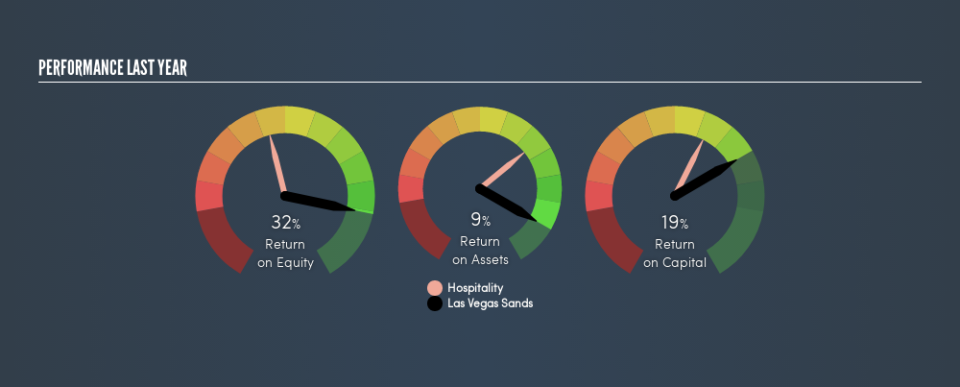A Close Look At Las Vegas Sands Corp.’s (NYSE:LVS) 19% ROCE

Want to participate in a short research study? Help shape the future of investing tools and you could win a $250 gift card!
Today we'll evaluate Las Vegas Sands Corp. (NYSE:LVS) to determine whether it could have potential as an investment idea. To be precise, we'll consider its Return On Capital Employed (ROCE), as that will inform our view of the quality of the business.
First of all, we'll work out how to calculate ROCE. Next, we'll compare it to others in its industry. Then we'll determine how its current liabilities are affecting its ROCE.
Understanding Return On Capital Employed (ROCE)
ROCE measures the 'return' (pre-tax profit) a company generates from capital employed in its business. In general, businesses with a higher ROCE are usually better quality. In brief, it is a useful tool, but it is not without drawbacks. Renowned investment researcher Michael Mauboussin has suggested that a high ROCE can indicate that 'one dollar invested in the company generates value of more than one dollar'.
How Do You Calculate Return On Capital Employed?
The formula for calculating the return on capital employed is:
Return on Capital Employed = Earnings Before Interest and Tax (EBIT) ÷ (Total Assets - Current Liabilities)
Or for Las Vegas Sands:
0.19 = US$3.7b ÷ (US$22b - US$2.9b) (Based on the trailing twelve months to March 2019.)
Therefore, Las Vegas Sands has an ROCE of 19%.
Check out our latest analysis for Las Vegas Sands
Is Las Vegas Sands's ROCE Good?
ROCE can be useful when making comparisons, such as between similar companies. Las Vegas Sands's ROCE appears to be substantially greater than the 9.4% average in the Hospitality industry. We consider this a positive sign, because it suggests it uses capital more efficiently than similar companies. Separate from Las Vegas Sands's performance relative to its industry, its ROCE in absolute terms looks satisfactory, and it may be worth researching in more depth.
Our data shows that Las Vegas Sands currently has an ROCE of 19%, compared to its ROCE of 15% 3 years ago. This makes us wonder if the company is improving. The image below shows how Las Vegas Sands's ROCE compares to its industry, and you can click it to see more detail on its past growth.
Remember that this metric is backwards looking - it shows what has happened in the past, and does not accurately predict the future. ROCE can be deceptive for cyclical businesses, as returns can look incredible in boom times, and terribly low in downturns. ROCE is, after all, simply a snap shot of a single year. Since the future is so important for investors, you should check out our free report on analyst forecasts for Las Vegas Sands.
Las Vegas Sands's Current Liabilities And Their Impact On Its ROCE
Current liabilities include invoices, such as supplier payments, short-term debt, or a tax bill, that need to be paid within 12 months. Due to the way the ROCE equation works, having large bills due in the near term can make it look as though a company has less capital employed, and thus a higher ROCE than usual. To counteract this, we check if a company has high current liabilities, relative to its total assets.
Las Vegas Sands has total liabilities of US$2.9b and total assets of US$22b. Therefore its current liabilities are equivalent to approximately 13% of its total assets. Current liabilities are minimal, limiting the impact on ROCE.
The Bottom Line On Las Vegas Sands's ROCE
This is good to see, and with a sound ROCE, Las Vegas Sands could be worth a closer look. Las Vegas Sands looks strong on this analysis, but there are plenty of other companies that could be a good opportunity . Here is a free list of companies growing earnings rapidly.
If you like to buy stocks alongside management, then you might just love this free list of companies. (Hint: insiders have been buying them).
We aim to bring you long-term focused research analysis driven by fundamental data. Note that our analysis may not factor in the latest price-sensitive company announcements or qualitative material.
If you spot an error that warrants correction, please contact the editor at editorial-team@simplywallst.com. This article by Simply Wall St is general in nature. It does not constitute a recommendation to buy or sell any stock, and does not take account of your objectives, or your financial situation. Simply Wall St has no position in the stocks mentioned. Thank you for reading.

 Yahoo Finance
Yahoo Finance 
